Introduction
The automotive lighting Industry has been witnessing unbound innovation and unprecedented advancements over the last few years. The ever-increasing technical advancement in automotive lighting has disrupted everything about the automotive interiors including the ambience, style, flexibility light source, appearance, technology etc. The demand for reliable and energy-efficient light sources has led to the evolution of automotive lighting from incandescent bulbs to LEDs to OLEDs.
The primary purpose of automotive exterior lighting is to ensure safety on road traffic. Based on its function, exterior lighting can be categorized mainly into two categories: lighting devices, which helps to see and signalling devices, which helps to be seen on the road. The lighting devices illuminates the road for the driver and the signalling devices increases the vehicle’s visibility or indicates its presence on the road. In addition to serving its purpose as a safety feature, automotive exterior lighting has also become an element of styling and personalization purposes.
The current automotive market needs highly efficient and cost-effective modular solutions for the lighting functions. The market needs optical systems with lower power demand and better thermal management.
In this whitepaper, we have attempted to understand automotive rear fog lighting, rear fog lamps, the existing technologies available in the market and analyse the available research on innovative rear fog lamp concepts, its merits, and shortcomings. The objective of this paper is to understand the scope of developing innovative and efficient optical system for rear fog lighting
Rear Fog Lamp
Rear fog lamp is used to make the vehicle easily visible from the rear by giving a red signal of greater intensity than the rear position lamp. The rear fog lamp reveals the position of our vehicle when driving in the fog, snow, or other weather conditions with limited visibility. Rear fog lamps play an important role in safe driving when the visibility is poor. In foggy or limited visibility weather conditions, the taillights are not seen clearly due to their lower intensity.
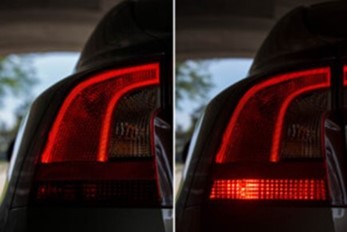
Rear fog lamp
The rear fog lamp lets other drivers know approximately where the vehicle is in a travel lane in foggy weather.
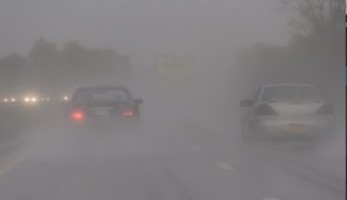
The purpose of this lamp is to emit a powerful and concentrated beam of red light that can penetrate harsh weather conditions such as fog and heavy rain. The absence of rear fog light in a vehicle significantly increases the chance of accidents during poor visibility conditions. Like the fog lights on the front of the car helps to make the
vehicle more visible to oncoming traffic, rear fog lights make the vehicle more visible to the traffic behind.
The rear fog light is mainly a safety device that should be used in limited visibility conditions, and it is not a styling element. The rear fog lights are not mandatory in US but their presence in vehicles is mandatory in the European vehicle market.
The optical concept or technology available in the current automotive market for achieving the rear fog function is mainly based on the reflector and collimator concept. The collimator-based system offers higher efficiency compared to the reflector-based systems. The collimator designs are available based on freeform collimator concept as well as conventional collimator concept. The freeform collimator designs offer high efficiency and better freedom of design while demanding more precise or accurate manufacturing or tooling.
The UN ECE regulation 38 specifies the performance and intensity requirements of a rear fog lamp for the European vehicle market. The ECE regulation requires a minimum intensity of 150 candelas (cd) along horizontal and vertical (H and V) axes between 10 degrees to left and right and 5 degree up and down and a maximum intensity of 300 cd in all directions. The regulation also requires a minimum intensity of 75 cd to be measured within a rhombus defined by extreme directions of measurement (that is 10 degrees to left and right and 5 degrees up and down of the reference axes).
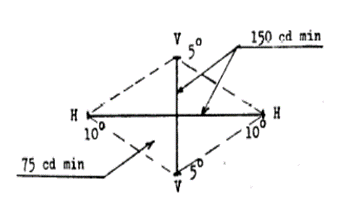
R38 photometry
Rear fog lamps based on reflectors and collimators are available in current automotive market such as the reflector-based lamps in Skoda Kushaq and VW Taigun.


Reflector based rear fog
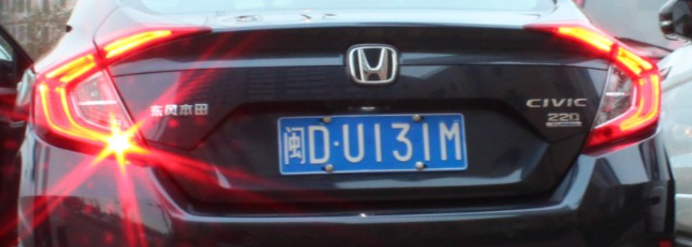
Collimator based rear fog lamp
There are also some rear fog lamp standard modules available in the market such as the Lumileds standardized rear fog module.
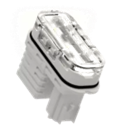
Lumileds Rear fog module
Literature study
Several research are being conducted in developing efficient rear fog solutions. Patents from Changzhou Xingyu Automotive Lighting Systems claims on different rear fog lamp structures based on different optical concepts.
Patent CN208779371U [1] claims about a rear fog lamp realized with freeform optics concept and LED light source. Rear fog distribution is achieved with freeform optical lens and input LED flux 60 lumen (lm) with the Osram LED KR DMLQ31.23. The model claimed is characterized in such a way that the ratio of the length and width of the outer surface/positive light emitting surface is 1.05 and the ratio of length and width of inlet surface/positive light entering curved surface is 1.1. The invention claims to achieve the rear fog distribution by concatenation of two lens with two KR DMLQ31.23 LEDs of luminous flux 30 lm each. The invention claims to be simple design with high optical efficiency and low cost. But as mentioned the invention, there needs to be a specific ratio of length and width of the light entering and light emitting surface needs to be maintained which limits its freedom to design for different styling requirements.
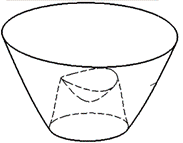
Freeform optical lens based rear fog module
Patent CN217004298 [2] claims about an LED based automobile rear fog module based on a light gathering structure concept. The light gathering structure has its outer surface fully covered with diffusion pattern. The diffusion pattern is formed by a matrix of square pattern units.
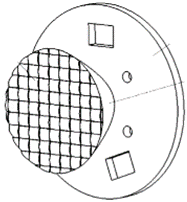
LED based rear fog module with diffusion pattern
Some of the pattern units of the diffusion pattern are horizontal diffusion structures and the rest are vertical diffusion structures. The horizontal and vertical diffusion structures are arranged alternatively in different combinations to achieve rear fog distribution. The presented model is claimed to have maximum light utilization and energy saving while achieving reasonable light pattern design. The claimed advantages of the proposed model are its usage of lesser number of LEDs, better thermal stability, and easy installation. The usage of diffusion pattern leads to light loss and increases the tooling cost.
Patent CN114636135 [3] has presented an automotive rear fog lamp module structure with light collection and light distribution optics (light incident and light emitting lampshade) and pattern array structures to achieve the rear fog light distribution. The light emitting lampshade/optic structure has polygonal array structures on its inner surface and outer surface.
The polygonal array structure on the inner surface of the light emitting lampshade is a diamond pattern structure and the polygonal array structure on the outer surface of the light emitting lampshade is a hexagonal pattern structure. The proposed module is claimed to reduce the influence of LED positioning on light distribution due to the double layer design/ polygonal array and the module claims to be suitable for different models thus saving product development cost.
The usage of additional optics/ additional optical elements leads to an increase in the tooling/manufacturing cost. There will be more light loss due to the additional optics.
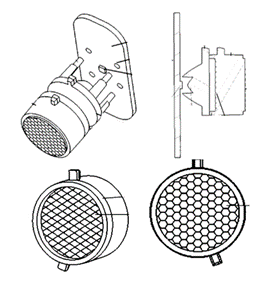
LED based rear fog module with polygonal array structures
The table above is a summary of the concept used in the available literature/existing innovative rear fog modules and its merits and demerits.
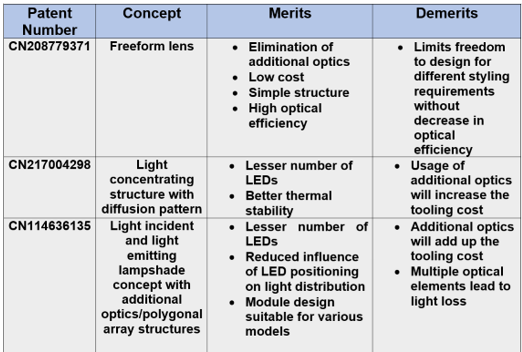
Conclusion
As per the analysis done on the available literature and existing solutions in the current automotive market for rear fog lamp, there is a need for optical systems with high energy efficiency to realize the rear fog function. There is a need for highly efficient, cost-effective systems which can achieve the rear fog distribution with limited or no additional optics other than primary optical part. The elimination of additional optical elements can significantly reduce the loss of light and hence improve the optical efficiency and reduce the tooling or manufacturing cost. The rear fog module should also have the freedom of design to meet different styling requirements without deterioration in optical efficiency.
References
